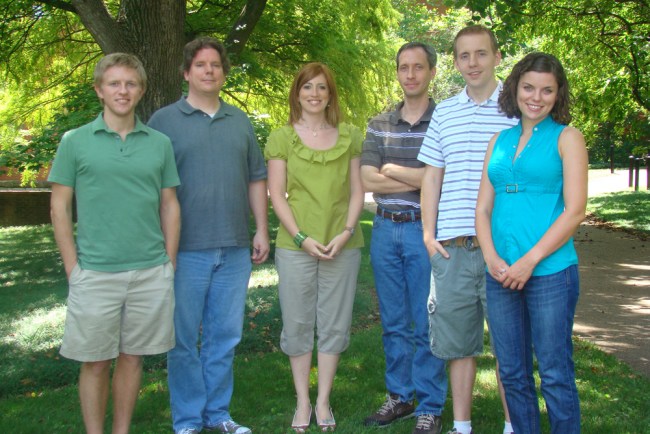
Marylyn Ritchie, Ph.D., third from left, and members of her lab, from left, Stephen Turner, Eric Torstenson, Scott Dudek, Ben Grady and Emily Holzinger.
Stimulus funds spur VMC research efforts
Marylyn Ritchie, Ph.D., will be able to accelerate her research at Vanderbilt Medical Center and nearly double her lab staff, thanks to $923,000 in federal stimulus money she will receive over the next two years.
“This is a huge grant,” said Ritchie, who directs the Computational Genomics Core. “There are a lot of people in Middle Tennessee who are unemployed statisticians.”
Ritchie's funding is among the first stimulus grants awarded in Tennessee by the National Institutes of Health (NIH) under the American Recovery and Reinvestment Act, which was signed into law by President Obama in February.
The NIH portion of the act, more than $10 billion, is designed “to help stimulate the U.S. economy through the support and advancement of scientific research,” federal officials said.
As of July 21, Vanderbilt University had received the lion's share of NIH stimulus grants in the state — 49 of 88 grants, totaling nearly $14 million over two years.
These grants are funding at least 50 new jobs at the Medical Center, including four or five new positions in the Ritchie lab. For a complete list of NIH stimulus grants, go to http://report.nih.gov/recovery.
Ritchie, an associate professor of Molecular Physiology and Biophysics, seeks to determine the connections between genetic and environmental factors that contribute to common, complex diseases like diabetes.
The goal of her project, which began July 1, “is to develop a way to integrate genetic data with other types of knowledge and with public databases,” she said.
Although the sequencing of the human genome has generated a mountain of data, it's not easy to extract meaningful information from it — even with the help of a supercomputer.
Studying the genome is analogous to climbing a mountain. Having fast computers can provide the climber with strength, stamina and good tools. What's required to reach the top, however, is a good route up the mountain — a strategy.
Supercomputers must be programmed to analyze data in ways that reveal the greatest amount of significant information. But it's going to take time to find the best route up the mountain.
“My approach to analysis is to look at the whole genome in an unbiased way,” said Ritchie, whose group is using the University's supercomputer, ACCRE (for Advanced Computing Center for Research and Education).
“When you begin to narrow your focus, you also narrow the range of possible discoveries.”













